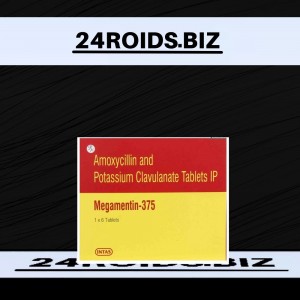Megamentin 375 is a breakthrough in the world of antibacterial treatment, offering patients a highly effective solution to various bacterial infections. This powerful medication is a combination of two active ingredients, amoxicillin and clavulanic acid, which work synergistically to combat a wide range of pathogens. The formula is designed to treat infections in various parts of the body, including the respiratory, urinary, and gastrointestinal systems.
The key to Megamentin 375’s success lies in its ability to attack bacteria on multiple fronts. Amoxicillin, a member of the penicillin family, interferes with the synthesis of bacterial cell walls, eventually causing them to rupture and die. Clavulanic acid, on the other hand, is a beta-lactamase inhibitor that protects amoxicillin from degradation by bacterial enzymes, thereby ensuring its effectiveness.
Megamentin 375 comes in the form of oral tablets, making it convenient for patients to take. The dosage and duration of treatment may vary depending on the type and severity of infection, as well as the patient’s age, weight, and overall health. It is crucial to follow the prescription guidelines provided by your healthcare professional to ensure the best possible results.
It is important to note that Megamentin 375 is only effective against bacterial infections and will not treat viral infections, such as the common cold or flu. Using antibiotics inappropriately can contribute to antibiotic resistance, a growing global health concern. Therefore, it is essential to use this medication only as prescribed by a healthcare professional.
Indications and Usage
Megamentin 375 is indicated for the treatment of various bacterial infections. Some of the most common infections it is prescribed for include sinusitis, bronchitis, and pneumonia, which affect the respiratory system. It is also effective in treating urinary tract infections, including cystitis and pyelonephritis, as well as bacterial infections in the gastrointestinal system, such as enteritis and colitis.
In addition to these common uses, Megamentin 375 has proven beneficial in treating skin and soft tissue infections, such as cellulitis and impetigo. Furthermore, it can be prescribed for dental infections, like periodontitis and abscesses, and even some gynecological infections, including bacterial vaginosis and pelvic inflammatory disease.
Megamentin 375 has also shown promise in preventing infections in certain situations. For instance, it may be prescribed prophylactically before dental procedures or surgeries to reduce the risk of postoperative complications due to bacterial infections.
While Megamentin 375 is highly effective against many bacterial strains, it is essential to remember that some bacteria may be resistant to its effects. In such cases, your healthcare professional may prescribe an alternative antibiotic to ensure proper treatment.
Side Effects and Precautions
As with any medication, Megamentin 375 can cause side effects in some patients. The most common side effects include nausea, vomiting, diarrhea, and stomach pain. These symptoms are usually mild and may subside as the body adjusts to the medication.
In rare cases, more severe side effects may occur, such as allergic reactions, severe diarrhea, or jaundice. If you experience any of these symptoms or suspect an allergic reaction, discontinue the medication and seek immediate medical attention.
It is crucial to inform your healthcare professional of any allergies, particularly to penicillin or other beta-lactam antibiotics, before starting Megamentin 375. Additionally, be sure to disclose any existing medical conditions, such as kidney or liver disease, and any other medications you are taking, as these may affect the suitability of Megamentin 375 or require dosage adjustments.
Pregnant and breastfeeding women should consult their healthcare professional before using Megamentin 375, as the medication may pose risks to the unborn child or be passed through breast milk. Your healthcare provider will weigh the potential benefits against the risks and advise you on the best course of action.
Interactions with Other Medications
Megamentin 375 may interact with other medications, which can affect its effectiveness or cause adverse effects. It is crucial to inform your healthcare professional of all medications, supplements, and herbal remedies you are taking before starting Megamentin 375 to prevent potential interactions.
Some medications that may interact with Megamentin 375 include anticoagulants, such as warfarin, which may increase the risk of bleeding. Other possible interactions include allopurinol, used to treat gout, and oral contraceptives, which may reduce the effectiveness of birth control.
Certain antibiotics, such as tetracyclines and macrolides, may interfere with Megamentin 375’s effectiveness, leading to treatment failure or increased side effects. It is essential to inform your healthcare professional if you are currently taking or have recently taken any other antibiotics.
Keep in mind that this list is not exhaustive, and other interactions may exist. Always consult your healthcare professional before starting any new medication to ensure it is safe to use with Megamentin 375.
Proper Storage and Disposal
Proper storage of Megamentin 375 is essential to maintain its effectiveness and ensure safety. Store the medication in its original container at room temperature, away from direct sunlight, moisture, and heat. Keep it out of reach of children and pets to prevent accidental ingestion.
If your medication has expired or is no longer needed, do not simply dispose of it in household trash or flush it down the toilet. Instead, consult your pharmacist or local waste disposal facility for guidance on the proper disposal of unused medication. This practice helps protect the environment and prevents the potential misuse of antibiotics.
In conclusion, Megamentin 375 is a highly effective antibacterial treatment for various bacterial infections. Its combination of amoxicillin and clavulanic acid provides a potent formula capable of targeting a wide range of pathogens. Always follow your healthcare professional’s advice and prescription guidelines when using this medication, and be aware of potential side effects and interactions. By doing so, you can ensure a safe and successful treatment experience.






